Liquid organic scintillators are utilized in detectors with many meters of volume. They are intended to be more radiation-resistant than crystalline or plastic scintillators. This is explored further in an article in the journal Quantum Beam Science.
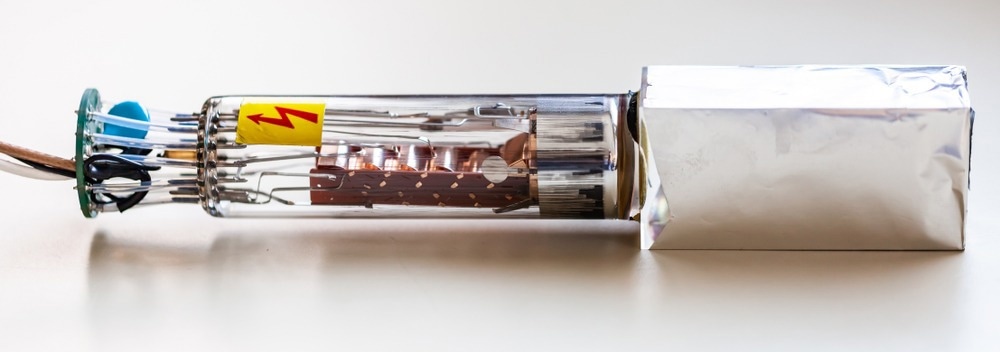
Study: Response to Mono-Energetic Neutrons and Light Output Function for Liquid Organic Scintillators PYR5/DIPN and THIO5/DIPN. Image Credit: Maksym Deliyergiyev/Shutterstock.com
The light output function (LOF) is a function of particle energy that is used to generate scintillator response functions. It is defined as the amount of light produced by an electron depositing the equivalent energy inside a scintillation crystal.
In this work, the light output function (LOF) of EJ-309, trans-stilbene, and small-molecule organic glass scintillators is measured. The work aims to extend the applicability of alternative and cheaper organic scintillators to the determination of neutron energy spectra.
The composition of two-component liquid organic scintillators using PYR and THIO luminophores and the DIPN solvent was studied to identify the optimum γ neutron discrimination capabilities.
Materials and Methods
The study investigated two liquid organic scintillators. DIPN (di-iso-propyl-naphthalene mixed isomers, CAS 38640-62-9, TCI Chemicals) is the solvent used.
Three different containers are used to study the scintillators:
The scintillators under study are mounted on a photomultiplier (PMT) and contained in a light-tight box., and the output of the photomultiplier is connected to NGA-01, which generates two outputs for each detected pulse.
The device works in a pulsed mode, which means that the measuring equipment is intended to capture every individual quantum of radiation that communicates with the detector. The energy channel and the discrimination channel are used to detect the type of particle.
The type is determined via pulse shape discrimination and, in particular, the charge comparison approach.
The response to neutron sources is monitored and acquired using NGA-01 output. The response function to neutron radiation and the response function to the γ radiation. The reaction is calibrated utilizing ray sources as a function of pulse number and corresponding electron energy L.
Results
Figure 1 depicts a two-parameter histogram of the DT reaction with energy of En=14 MeV, and the FOM function is used to define the discrimination.
Figure 1b depicts the FOM for the previously indicated measurement. Above 0.2 Me Vee, excellent discrimination is seen, and the FOM approaches a value of two for higher energies.
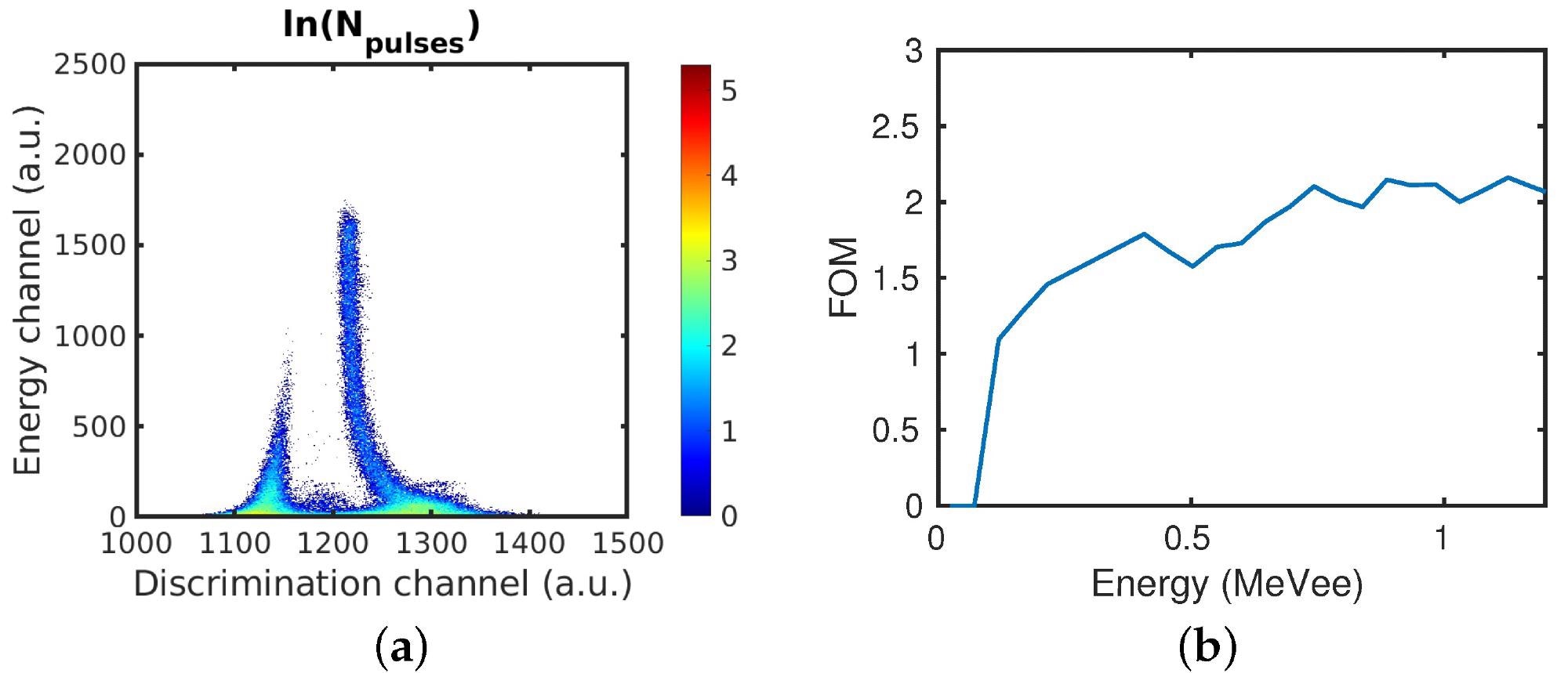
Figure 1. (a) Two-parameter histogram of the DT reaction with an energy of En=14MeV detected using a 1-inch PYR5/DIPN scintillator. (b) FOM for the same measurement. Image Credit: Jansky, J, et al., 2022
Two examples of measured response functions for neutrons from the DT reaction with an energy of 14 MeV are shown in Figure 2. Figure 2a shows the number of pulses seen as a function of the equivalent electron energy L for neutrons detected from the DT reaction using the 1-inch PYR5/DIPN scintillator with an energy of En=14MeV.
The edge is detected about L=8MeVee. The corresponding electron energy L=7.707MeVee is calculated from this edge.
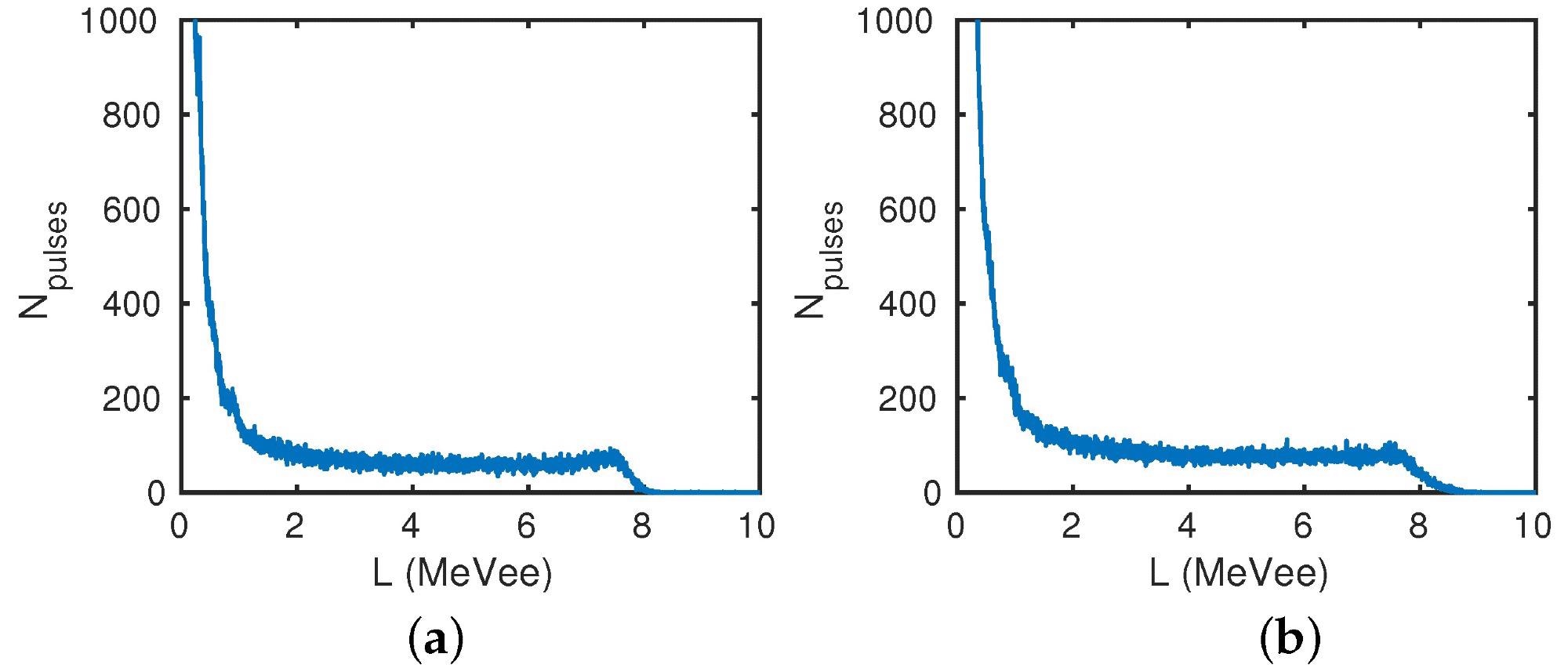
Figure 2. (a) Two-parameter histogram of the DT reaction with an energy of En=14MeV detected using a 1-inch PYR5/DIPN scintillator. (b) FOM for the same measurement. Image Credit: Jansky, J, et al., 2022
Figure 2b depicts the number of recorded pulses as a function of the equivalent electron energy L for neutrons detected using the 1-inch THIO5/DIPN scintillator with an energy of En=14MeV from the DT reaction. The margin around L=8 MeVee is also visible.
The analogous electron energy L=7.923 MeVee is calculated from this edge. The comparable electron energy values are extremely similar. The PYR5/DIPN scintillator has a thinner edge, resulting in improved energy resolution.
In Figure 3, the light output function for all measurements performed is shown. The data points have the same dependence, and the discrepancies between containers are within the measurement uncertainty range.
Figure 3a depicts the PYR5/DIPN scintillator’s light output function, whereas Figure 3b depicts the THIO5/DIPN scintillator’s light output function.
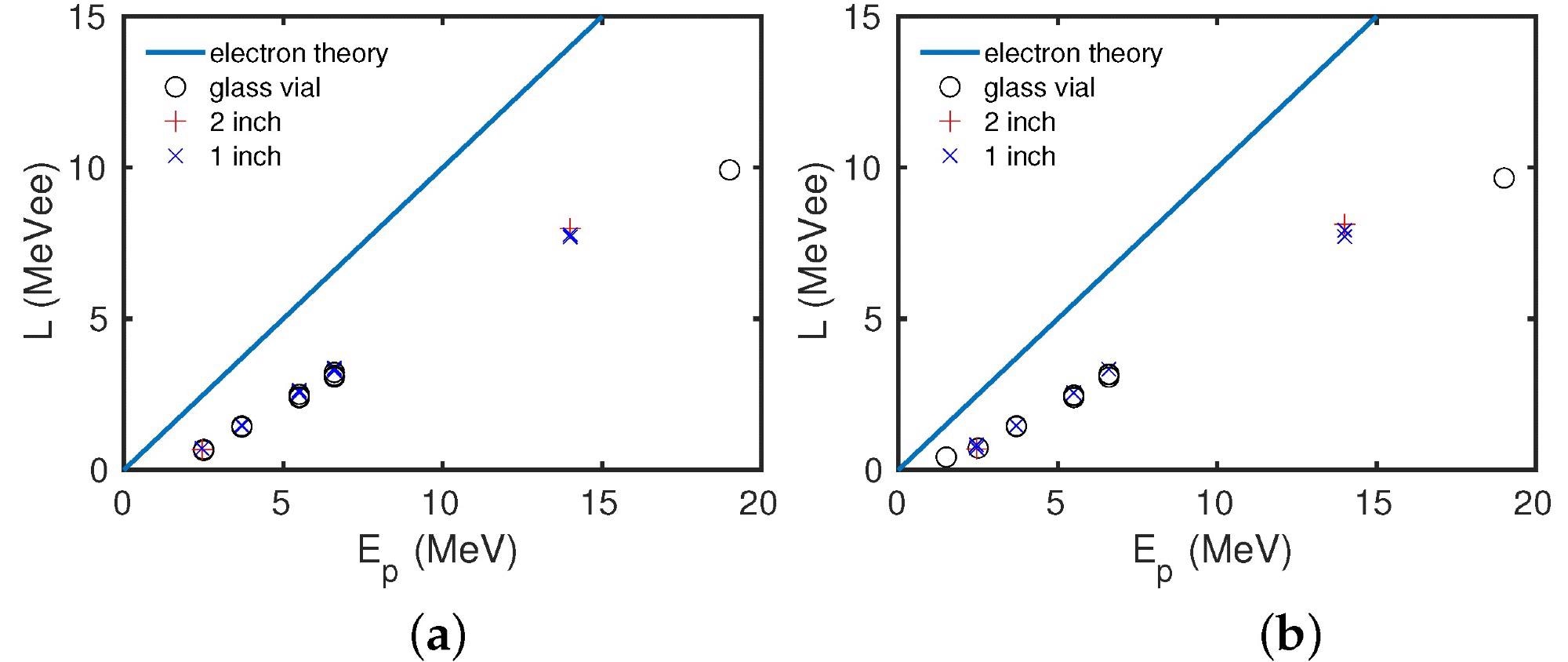
Figure 3. Light output function for all measurements detected using (a) PYR5/DIPN scintillator, (b) THIO5/DIPN scintillator. Image Credit: Jansky, J, et al., 2022
The fit function for scintillators is served better as a periodic function, with the fit parameters listed in Table 1 and the fit function illustrated with data points in Figure 4.
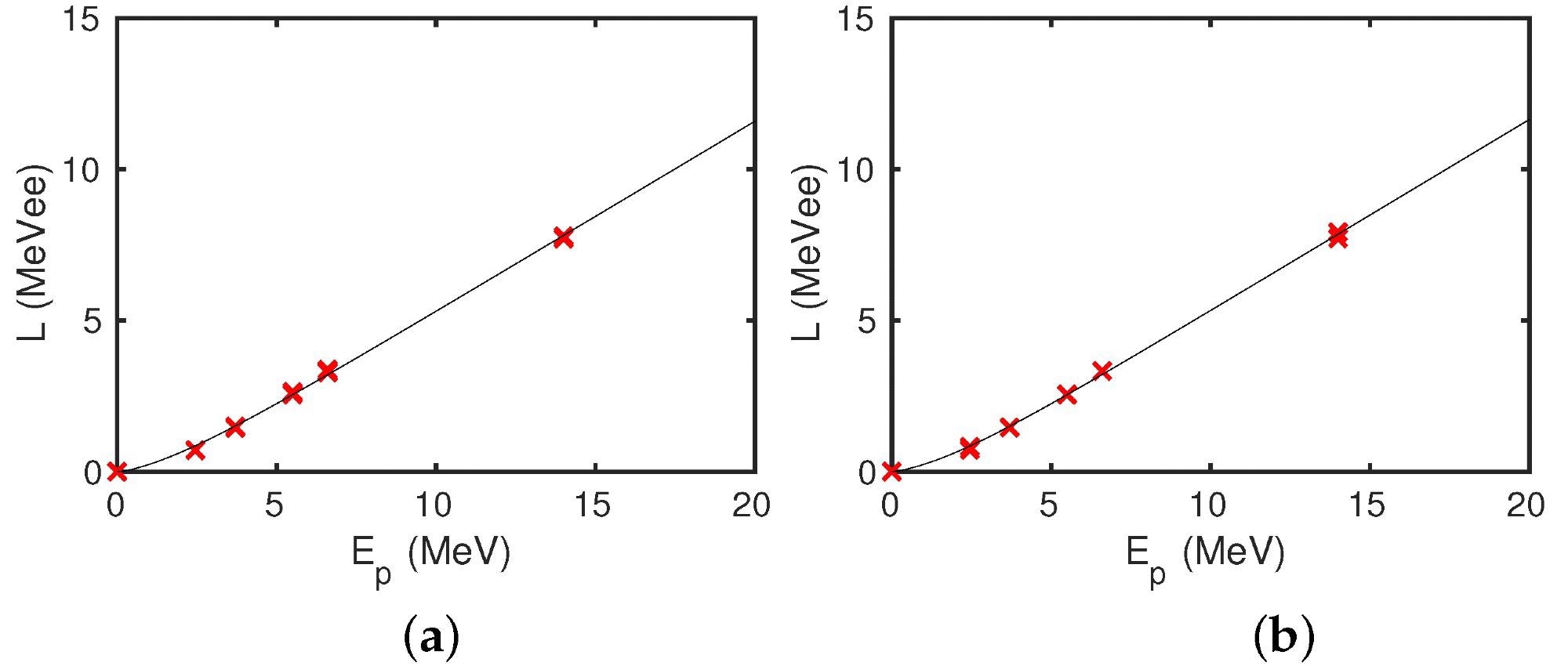
Figure 4. Light output function for all measurements detected using a 1-inch (a) PYR5/DIPN scintillator, and (b) THIO5/DIPN scintillator. The data points are completed with fit functions for each scintillator. Image Credit: Jansky, J, et al., 2022
Table 1. Table of coefficients for the LOF fits for both scintillators. The fit function is: L=aEp−b(1−exp(−cEdp)). Source: Jansky, J, et al., 2022
| Scintillator |
a |
b |
c |
d |
| PYR5/DIPN |
0.6294 |
1.0000 |
0.4933 |
0.9500 |
| THIO5/DIPN |
0.6323 |
1.0000 |
0.4986 |
0.9883 |
Discussion
Figure 2 shows the predicted results, and the measured data points for the electron equivalent energy L in Figure 3 closely resemble the shape of the known LOF functions.
The energy redistribution following a neutron impact with a hydrogen atom causes the non-linearity of stilbene’s light output function (LOF). This distribution fluctuates nonlinearly in relation to incoming neutron energy.
For Ep>10MeV, it can also be observed that the LOF function of stilbene relies on the size of the stilbene crystal. Taking into account the range and amount of data points in this study, the independence of the LOF on a container can be regarded genuine for Ep7MeV, with additional data points required for higher Ep.
It is also worth noting that the L for stilbene is less than the L for the scintillators. Then, in stilbene, there is a greater disparity between electron and proton light emission. That might be one of the reasons stilbene is so good at distinguishing between rays and neutrons.
These findings will be utilized to create a response matrix for our scintillators in the future. The neutron energy spectra will then be obtained using the scintillators PYR5/DIPN and THIO5/DIPN.
Conclusion
On the PYR5/DIPN scintillator, the study found the light output function for protons L(Ep)=0.6294Ep1.00(1–exp (–0.4933E0.95p)). On the THIO5/DIPN scintillator, they also got the light output function for protons, L(Ep)=0.6323Ep1.00(1–exp (–0.4986E0.9883p)).
Journal Reference:
Jansky. J, Janda. J, Košťál. M, Matěj. Z, Bílý. T, Mazánková. V, Mravec. F, and Cvachovec. F. (2022) Response to Mono-Energetic Neutrons and Light Output Function for Liquid Organic Scintillators PYR5/DIPN and THIO5/DIPN. Quantum Beam Sci, 6(2), 18. Available Online: https://www.mdpi.com/2412-382X/6/2/18/htm
References and Further Reading
- Knoll, G F (2010)Radiation Detection and Measurement. In: John Wiley & Sons, New York, NY, USA.
- Hansen, W & Richter, D (2002) Determination of light output function and angle dependent correction for a stilbene crystal scintillation neutron spectrometer. Nuclear Instruments and Methods in Physics Research Section A: Accelerators, Spectrometers, Detectors and Associated Equipment, 476(1–2), pp. 195–199. doi.org/10.1016/S0168-9002(01)01430-9.
- Norsworthy, M. A., et al. (2017) Evaluation of neutron light output response functions in EJ-309 organic scintillators. Nuclear Instruments and Methods in Physics Research Section A: Accelerators, Spectrometers, Detectors and Associated Equipment, 842, pp. 20–27. doi.org/10.1016/j.nima.2016.10.035.
- Shin, T. H., et al. (2019) Measured neutron light-output response for trans-stilbene and small-molecule organic glass scintillators. Nuclear Instruments and Methods in Physics Research Section A: Accelerators, Spectrometers, Detectors and Associated Equipment, 939, pp. 36–45. doi.org/10.1016/j.nima.2019.05.036.
- Jánský, J., et al. (2021) Optimization of composition of liquid organic scintillators for fast neutron spectrometry. Nuclear Instruments and Methods in Physics Research Section A: Accelerators, Spectrometers, Detectors and Associated Equipment, 1010, p. 165523. doi.org/10.1016/j.nima.2021.165523.
- Janda, J., et al. (2021) The Long-term Stability of Liquid Organic Scintillators Used for Gamma-neutron Separation. IEEE Transactions on Nuclear Science, 69(4), pp. 768–776. doi.org/10.1109/TNS.2021.3111635.
- Juříček, V., et al. (2021) The Application of Silicon-Filtered Beam in the Validation of Iron Cross Sections by Deep Penetration Experiments. Journal of Nuclear Engineering and Radiation Science, 7(2), p. 022005. doi.org/10.1115/1.4049726.
- Veškrna, M., et al. (2014) Digitalized two parametric system for gamma/neutron spectrometry. In: 18th Topical Meeting of the Radiation Protection & Shielding Division of ANS, Knoxville, TN, USA, 14–18 September 2014. Available at: https://is.muni.cz/publication/1210637/RPSD2014_-_Digitalized_two_parametric_system_for_gammaneutron_spectrometry.pdf
- Košt’ál, M., et al. (2015) Comparison of fast neutron spectra in graphite and FLINA salt inserted in well-defined core assembled in LR-0 reactor. Annals of Nuclear Energy, 83, pp. 216–225. doi.org/10.1016/j.anucene.2015.04.011.
- Košt’ál, M., et al. (2017) Measurement and calculation of fast neutron and gamma spectra in well defined cores in LR-0 reactor. Applied Radiation and Isotopes, 120, pp. 45–50. doi.org/10.1016/j.apradiso.2016.11.004.
- Mravec, F (2017) Numerical Processing of Spectrometric Data. Ph.D. Thesis, Faculty of Informatics, Masaryk University, Brno, Czech Republic, 2017. Available at: https://is.muni.cz/th/k7ff9/thesis.pdf
- Brooks, F D (1959) A scintillation counter with neutron and gamma-ray discriminators. Nuclear Instruments and Methods, 4(3), pp. 151–163. doi.org/10.1016/0029-554X(59)90067-9.
- Kaschuck, Y & Esposito, B (2005) Neutron/γ-ray digital pulse shape discrimination with organic scintillators. Nuclear Instruments and Methods in Physics Research Section A: Accelerators, Spectrometers, Detectors and Associated Equipment, 551(2–3), pp. 420–428. doi.org/10.1016/j.nima.2005.05.071.
- Howarth, P (1996) High count rate performance of NE213 scintillation detectors with associated pulse shape discrimination electronics. Nuclear Instruments and Methods in Physics Research Section A: Accelerators, Spectrometers, Detectors and Associated Equipment, 376(1), pp. 67–81. doi.org/10.1016/0168-9002(96)00196-9.
- Safari, M. J., et al. (2016) Differentiation method for localization of Compton edge in organic scintillation detectors.. doi.org/10.48550/arXiv.1610.09185
- Savitzky, A & Golay, M J (1964) Smoothing and differentiation of data by simplified least squares procedures. Analytical Chemistry, 36(8), pp. 1627–1639. doi.org/10.1021/ac60214a047.
- Schafer, R W (2011) What Is a Savitzky-Golay Filter? [Lecture Notes]. IEEE Signal Processing Magazine, 28(4), pp. 111–117. doi.org/10.1109/MSP.2011.941097.
- Cecil, R. A., et al. (1979) Improved predections of neutron detection efficiency for hydrocarbon scintillators from 1 MeV to about 300 MeV. Nuclear Instruments and Methods, 161(3), pp. 439–447. doi.org/10.1016/0029-554X(79)90417-8.